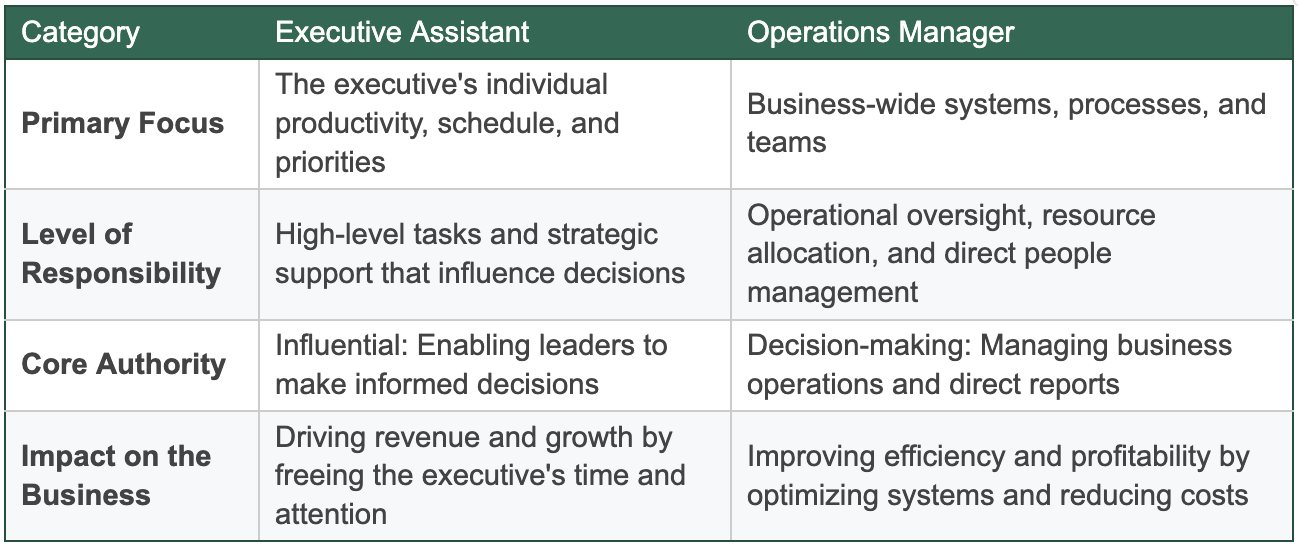Executive Assistant vs. Operations Manager: Find Support for Your Leadership Goals

Table of contents
The Path to Becoming an Athena Assistant
Only the top 1% of applicants make it to the Athena Bootcamp – an acceptance rate more exclusive than Harvard University.
It’s a classic leadership dilemma: Your business is growing, and you need help. As companies grow and current teams stretch, opportunities present to scale the business by bringing in new people. But what kind of help moves the needle in the right direction? Do you hire someone to manage companywide operations or a partner to strategize alongside you, freeing you up to focus on high-impact work? Depending on your needs, you might consider bringing on an operations manager (OM) or an executive assistant (EA).
Understanding what an executive assistant is and what an operations manager is can help you clarify their key differences. While an OM focuses on business-wide processes, EAs partner directly with leaders to boost productivity through strategic support, efficient workflows, and proactive execution. Read on to learn more about these key roles, and discover how Athena helps improve leadership bandwidth and organizations’ long-term growth.
What Does an Executive Assistant Do?
An EA does more than administrative tasks — they’re a strategic partner for an organization’s leaders. A well-trained EA focuses on project management, participates in planning, and streamlines workflows. They help executives make decisions and take the lead on implementing them, ultimately creating time and space for leadership to get high-level tasks done. Here’s a look at some of the responsibilities EAs can handle:
- Managing relationships and communications: EAs are gatekeepers who protect leaders’ time and inboxes. This involves managing email, screening calls, and filtering requests for time to ensure only the important matters reach executives.
- Assisting with strategic planning and follow-ups: This is where EAs go far beyond administrative tasks and function as partners. They help prepare for high-level meetings by creating agendas, preparing briefing documents, and doing preliminary research. Post meeting, EAs assign action items and ensure they’re handled efficiently.
- Tracking and coordinating key projects: Once an initiative is underway, EAs become project managers. They’re the central point of contact and coordination. They monitor timelines, update the team, and deal with problems without needing constant executive oversight.
- Conducting research and summarizing findings: EAs perform analysis on markets and competition and assess potential investments, synthesizing this information into reports and presentations that executives can easily digest and act on.
- Planning and organizing executive events: EAs organize and manage the logistics of high-level events critical to company culture and business growth. They oversee key details — like venues, travel, and agendas — so everyone else only has to show up.
Athena’s EAs can do all the above and are backed with one-on-one coaching to continuously hone their skills. They’re trusted collaborators trained to anticipate needs, streamline operations, and drive growth. Get started with an Athena Assistant.
What Does an Operations Manager Do?
While EAs focus on empowering and partnering with executives, OMs keep an entire business running smoothly. A typical OM role consists of:
- Streamlining workflows: In some ways, OMs are like EAs. They’re efficiency experts able to create and refine existing structures and protocols — from order fulfillment to the customer experience — so processes run smoothly with no redundancy.
- Strategically allocating resources: OMs are stewards of a company’s budget. They ensure inventory and labor align with goals and optimize the relationship between revenue and expenditures. They aim for scale while maintaining profitability.
- Managing day-to-day operations: OMs oversee day-to-day business functions. If something comes up in logistics, the supply chain, and with a customer or vendor, the OM deals with it. They solve problems before they disrupt the business.
- Monitoring performance metrics: OMs use key performance indicators (KPIs) and other data to track productivity and company goals and objectives with an eye on financial results. They analyze trends and patterns and identify ways to improve a company’s overall financial and operational health.
Key Differences Between Executive Assistants and Operations Managers
While there can be overlap between the two, the duties and decision-making authority between EAs and OMs are distinct.

Essential Skills: Executive Assistant vs. Operations Manager
Both roles require excellent organizational and communication skills, but their core skillsets should be distinct. EAs need skills to engage in a strategic partnership with a high-level professional, while OMs focus on greater business needs.
Skills an Executive Assistant Should Have
A top-notch EA adds value by anticipating a leader’s needs, acting with purpose and autonomy to meet them. They contribute to strategic planning and have enough authority where they can make decisions without asking — freeing up the executive’s time to focus on high-impact work. Necessary skills an EA needs include:
- Strategic planning and prioritization: EAs align executive schedules with priorities. They prepare execs for meetings and thoughtfully organize their time to balance near- and long-term initiatives.
- Decision-making: Once they establish a partnership with the executive they support, an EA doesn’t have to ask for permission. They know the extent of their authority, and can act on the executive’s behalf to solve problems and seize opportunities as they come up.
- Research and analysis: EAs need research skills beyond basic data gathering. They must be able to analyze data and distill it into clear and concise recommendations so executives can make quick, and confident decisions.
- Leadership skills: EAs lead with influence and operate with the delegated authority executives give them. They act decisively, driving team management, strategic planning, and both external and internal communications.
Skills an Operations Manager Should Have
A great OM knows business processes inside and out. They know how to manage day-to-day logistics for maximum efficiency. Key skills an OM will bring to an organization include:
- Logistics and supply chain management: Think of an OM as the person who ensures all the moving parts — resources, inventory, personnel — combine to create an efficient whole. They coordinate and optimize physical and digital workflows so the business runs like a well-oiled machine.
- Continuous process improvement: If there’s inefficiency, a good OM sees it and fixes it. They don’t like friction, and they know how to remove it. Even when things are running smoothly, a strong OM searches for ways to increase efficiency.
- Client and vendor relations: If a client or vendor has a problem, the OM addresses and solves it. They’re the go-to person on the organizational team to take care of issues before they become bigger problems and affect key relationships.
- Financial administration: An OM’s duties often include operational management of company finances. This can involve overseeing payroll, budgets, and compliance.
How To Choose Between an Operations Manager and an Executive Assistant
OMs and EAs play complementary roles within many businesses. That’s why many organizations have both. But if you only have the need or budget for one, here’s how to decide:
- Assess your business needs: Identify your most urgent challenge. If you or a key executive is bogged down in meetings or mundane tasks, go with an EA who can provide immediate support. If your issues are mostly operational — like managing logistics, resources, and daily operations — an OM makes the most sense.
- Understand the difference in scope: EAs help keep leaders focused on high-level priorities. An OM focuses on operational aspects, striving for continuous improvements by constantly assessing and streamlining workflows.
- Consider team structure and leadership: Larger companies with multiple departments often need an OM to keep everything organized and in sync. Smaller businesses, such as startups or companies with fewer management layers, can use an EA as a source of centralized support and strategic guidance.
- Evaluate the impact on productivity: If the CEO or another top executive has more time, will you see an immediate return? If so, an EA is the answer. But if optimizing workflows with a focus on organizational development can generate a larger return right now, an OM is a better fit.
- Factor in career development potential: Consider where the role can lead. An EA can grow into a senior position such as chief of staff, whereas an OM could become director of operations or chief operating officer. Think about how the decision between an EA and an OM can impact both the individual you hire and your company’s growth long-term.
Get Started With an Athena Assistant
Athena’s EAs aren’t merely administrative or personal assistants. While they cover some duties of those roles, they also function as project managers and high-level researchers who facilitate operations while acting as strategic partners. Athena EAs handle time-consuming tasks, such as scheduling meetings and preparing expense reports, while offering proactive, high-level support and guidance. This enables leaders to focus on impactful work and reach their full leadership potential.
Athena Assistants are experienced professionals who adapt their support to fit your organization’s needs. Get started with an Athena Assistant today
You might also like
No items found.










